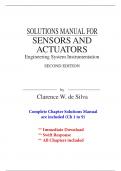Exam (elaborations)
Solutions for Sensors and Actuators: Engineering System Instrumentation, 2nd Edition Silva (All Chapters included)
- Course
- Institution
Complete Solutions Manual for Sensors and Actuators: Engineering System Instrumentation, 2nd Edition by Clarence W. de Silva ; ISBN13: 9781466506817. (Full Chapters included Chapter 1 to 9)....1.Instrumentation of an Engineering System 2.Component Interconnection and Signal Conditioning 3.Perform...
[Show more]



